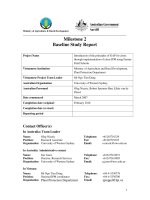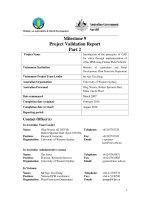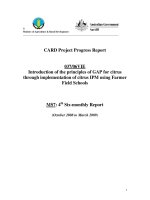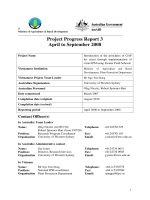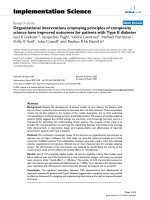02 principles of wto
Bạn đang xem bản rút gọn của tài liệu. Xem và tải ngay bản đầy đủ của tài liệu tại đây (138.94 KB, 28 trang )
SOUTH EAST ASIA
TRADE POLICY
TRAINING NETWORK
INTRODUCTION TO TRADE POLICY AND THE WTO
MODULE 8
The World Trade Organization
1
SOUTH EAST ASIA
TRADE POLICY
TRAINING NETWORK
Functions of the WTO
•
•
•
•
•
Administers trade agreements
Acts as a forum for negotiations
Works to settle trade disputes
Reviews national trade policies
Assists developing countries with trade
policy
• Cooperates on subjects of mutual interest
with other organizations
2
SOUTH EAST ASIA
TRADE POLICY
TRAINING NETWORK
Membership and Decision-making
in the WTO
• Some 150 member countries, accounting
for over 97% of world trade
• Some 30 other countries are negotiating
membership.
• Decisions are made by entire membership.
• While a majority vote is possible,
decisions are usually by consensus.
3
SOUTH EAST ASIA
TRADE POLICY
TRAINING NETWORK
Structure of the WTO
• A Ministerial Conference meets every two years.
• General Council meets regularly at level of
Ambassadors.
• Goods Council administers GATT (including
agriculture).
• Services Council administers GATS.
• Intellectual Property Council administers TRIPS.
4
SOUTH EAST ASIA
TRADE POLICY TRAINING
NETWORK
Organs of the WTO
MINISTERIAL CONFERENCE
• TNC
DSB
General Council
• Trade &
Environment
Committee
TPRM
Council for
Trade in Goods
Goods Committees
Annex 1A,
WTO Agreement
Council for
Trade in Services
Services
Committees
•Council for
•TRIPS
• Trade &
Development
Committee
• BOP
Committee
• Budget,
Finance &
Administration
Committee
5
SOUTH EAST ASIA
TRADE POLICY
TRAINING NETWORK
Secretariat of the WTO
• Director General and Deputy positions
selected by members (usually political
and term limited)
• Staff of over 500; all in Geneva
• Secretariat has no decision-making
powers.
• Provides technical and legal support to
councils, committees, working parties and
to developing countries
6
SOUTH EAST ASIA
TRADE POLICY
TRAINING NETWORK
WTO Mission Statement
• The World Trade Organization is the only
international organization dealing with the
global rules of trade between nations. Its
main function is to ensure that trade flows
as smoothly, predictably and freely as
possible.
7
SOUTH EAST ASIA
TRADE POLICY
TRAINING NETWORK
WTO Agreements
• These form the heart of the multilateral trading
system.
• Negotiated, signed and ratified by member
nations
• Provide legal ground rules for international
commerce
• Guarantee member countries important trade
rights
• Committed governments to keep their trade
policies within agreed limits
8
SOUTH EAST ASIA
TRADE POLICY
TRAINING NETWORK
WTO Agreements
• In principle remove power politics from
trade negotiations and dispute settlement.
• Impose costs on Governments who want
to or have to take economic decisions that
break agreements into which they have
entered.
9
SOUTH EAST ASIA
TRADE POLICY
TRAINING NETWORK
WTO’s Fundamental Principles
• Complicated legal agreement guiding the
international trading system
• Based on five, easy to understand, principles:
– Trade without discrimination
– Freer trade, gradually, through negotiation
– Predictability, through binding and
transparency
– Promoting fair competition
– Encouraging development and economic
reform
10
SOUTH EAST ASIA
TRADE POLICY
TRAINING NETWORK
Trade without discrimination
• This means treating all member countries
equally.
• It is formally known as the MostFavoured-nation (MFN) Principle.
• For example, if a WTO member lowers
its customs duty for a product imported
from one other member country, it must
also give the same concession to all other
members.
11
SOUTH EAST ASIA
TRADE POLICY
TRAINING NETWORK
Trade without discrimination
• Members must also not discriminate
between domestic and foreign goods,
services or nationals once they have
entered the market.
• This is known as National Treatment.
12
SOUTH EAST ASIA
TRADE POLICY
TRAINING NETWORK
Trade without Discrimination
• A few exceptions are permitted:
– For partners in a free trade agreement
– For extending better access to
developing countries
– General waivers
– To protect morals, human and animal
health and National Security
– To counteract unfairly traded products
13
SOUTH EAST ASIA
TRADE POLICY
TRAINING NETWORK
Freer Trade Gradually,
through negotiation
• The WTO encourages fair trade by
disciplining barriers related to:
– Tariffs
– Import bans or quotas
– Other issues
• Now into 9th round of liberalizing
negotiations (8 under GATT)
14
Predictability through Binding
and Transparency
SOUTH EAST ASIA
TRADE POLICY
TRAINING NETWORK
• “Binding” means setting a fixed upper
limit on tariffs and other commitments
– Provides stability and predictability
– Can be changed only after negotiations
with trading partners
– NOTE: 100% of agriculture products
of developed countries have bound
tariff rates.
15
SOUTH EAST ASIA
TRADE POLICY
TRAINING NETWORK
Binding and Transparency
• The WTO discourages the use of less
visible and less predictable barriers (e.g.
Quotas)
• It encourages transparency through
requirements to disclose policies and
practices and notify WTO of changes.
• Conducts trade policy reviews
16
SOUTH EAST ASIA
TRADE POLICY
TRAINING NETWORK
Promoting Fair
Competition
• Rules to establish what is considered fair
and unfair competition (e.g. Dumping and
subsidies are considered unfair
competition.)
• Rules to establish how governments can
respond to trade disputes.
• Specific agreements, such as that on
agriculture, aim to support fair
competition.
17
SOUTH EAST ASIA
TRADE POLICY
TRAINING NETWORK
Encourage Development
and Economic Reform
• Fully three quarters of WTO members are
developing or transition economies.
• WTO rules and mechanisms provide
– more time for developing countries to
implement undertakings.
– special assistance (training, legal advice).
– trade concessions (generalized system of
tariff preferences).
– extend Special and Differential Treatment.
18
SOUTH EAST ASIA
TRADE POLICY
TRAINING NETWORK
Contingent Protection
• Contingent Protection rights exist for
special circumstances:
– Unfair trade is considered to be trade
which is distorted by some action of
Government or the private sector.
– Where proven to exist and to be hurting
competition, the importing country can
take action.
19
SOUTH EAST ASIA
TRADE POLICY
TRAINING NETWORK
Contingent Protection
• Several important types of practices qualify:
– Dumping
– Subsidizing production and export
• Safeguards provide a legal trade remedy that
permit countries to protect domestic industry
against fairly traded products when subject
to disruption.
20
SOUTH EAST ASIA
TRADE POLICY
TRAINING NETWORK
Dumping
• Means selling a good at less than its “normal”
value
- usually the price in the home market or the
cost of production
• Is the result of an action by the company
involved and outside control of Government
• If an industry makes an allegation, an
investigation is required to prove dumping and
its value.
• If dumped sales cause material injury to
domestic interests, then dumping duties can be
applied equal to amount of dumping margin.
21
SOUTH EAST ASIA
TRADE POLICY
TRAINING NETWORK
Dumping
• Material injury
– To impose a “dumping duty”, it must be
shown that injury has occurred
– Injury can take many forms:
• Lost sales
• Lost profits
• Reduced employment
• Unused factory capacity
22
SOUTH EAST ASIA
TRADE POLICY
TRAINING NETWORK
Dumping
• Injury must be found to be material.
• No standard definition of what is
“material.” It is left to each country to set
limit
• Dumping duties remain in effect as long as
the action is taking place.
• Countries can enter into a price
undertaking (not to dump) and have duties
waived.
23
SOUTH EAST ASIA
TRADE POLICY
TRAINING NETWORK
Subsidized Production and
Export
• Governments sometimes provide monetary
support to their producers.
• Some subsidies are given for industrial
development reasons.
• Only non-generally available support is
actionable
• Support given only when products are exported
is prohibited by the WTO
- If found to exist actions can be taken to
eliminate them
24
SOUTH EAST ASIA
TRADE POLICY
TRAINING NETWORK
Subsidies
• Investigation is carried out to determine
existence and level of support
-Next steps depend on level
• Another investigation is undertaken to
determine if there is material injury to
domestic producers in the importing country
• If there is, then a “countervailing” duty is
imposed to match the subsidy
• Stays in effect as long as the subsidy is paid.
25

